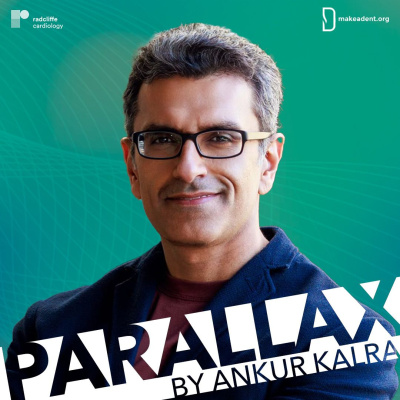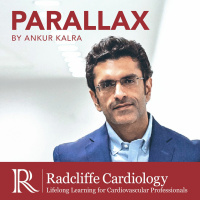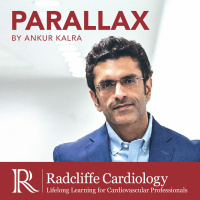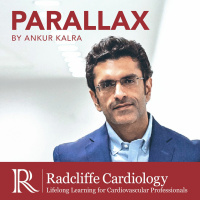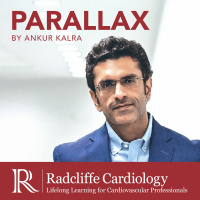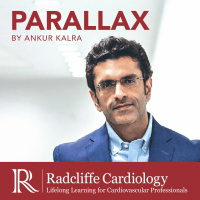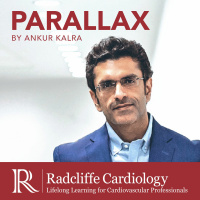Synopsis
‘Parallax’ (/?par?laks/)-noun: the effect whereby the position or direction of an object appears to differ when viewed from different positions. Join Ankur Kalra, MD from Cleveland Clinic as he shows you a different side to cardiovascular care, management and science. Listen to Ankur’s conversations with legendary cardiologists, critical reviews of key congresses and late-breaking trials, and concise summaries of the best US Cardiology Review articles (we call them #AudioArticles!). Published every second Monday of the month, this is your fix of reliable updates on all things cardiology by someone from a non-traditional background, who is always trying to look at it from new angles! Dear cardiologists, we want to make this podcast about you, and for you! Please email us critical thoughts, comments and questions for Ankur at podcast@radcliffe-group.com and visit www.uscjournal.com for more.
Episodes
-
05: Role of drug-coated balloons in small-vessel CAD with Emmanouil S Brilakis and Michael Megaly
28/05/2019 Duration: 27minListen to our first episode with two guests! Ankur spoke with Emmanouil S Brilakis, MD and Michael Megaly, MD from the Minneapolis Heart Institute, Abbott Northwestern Hospital about their article on the role of drug-coated balloons in small-vessel coronary artery disease (SVD) published in US Cardiology Review 13.1. Percutaneous coronary intervention of SVD remains challenging due to difficulties with device delivery and high restenosis rate, making drug-coated balloons an attractive emerging option in patients with SVD. In this brilliant conversation, Ankur, Emmanouil and Michael unravel the potential advantages, challenges and practical realities of using drug-coated balloons in SVD, and the findings of the latest randomised controlled trials studying this area. Hosted by @AnkurKalraMD. Produced by @RadcliffeCardiology. [Disclaimer: The use of drug-coated balloons in coronary intervention is still off-label; it has not been approved by the FDA.]
-
04: J Dawn Abbott on recent developments in percutaneous coronary intervention
13/05/2019 Duration: 34minWe have observed a lot of developments in percutaneous coronary intervention (PCI) over the past 12 months with the publication of various studies and trials. This week, Ankur spoke with J. Dawn Abbott, MD, Associate Professor of Cardiology at Warren Alpert Medical School of Brown University about her recently published US Cardiology Review 13.1 article on the significant developments in PCI over the past 12 months. Dawn is an associate editor of the journal Circulation: Cardiovascular Interventions and is widely known for her research program on PCI and peripheral arterial disease (PAD). Ankur and J. Dawn discuss multiple trials/studies that were published in 2018, including ORBITA, PIONEER-II and ABSORB. J. Dawn also shares her thoughts on the latest stent technologies. Hosted by @AnkurKalraMD. Produced by @RadcliffeCardiology.
-
03: Athena Poppas on effective management of hypertension
10/05/2019 Duration: 29minThis week’s podcast guest needs no introduction! Prof Athena Poppas is one of the most widely known cardiologists in the US and current Vice-President of the American College of Cardiology! Ankur spoke to Athena about her recently published US Cardiology Review 13.1 article on whether early management of hypertension by GPs can improve outcomes. They discuss the importance of preventative medicine, their experience of reducing hypertension with non-pharmaceutical and pharmaceutical methods, and the significance of the integrated “team approach” when treating comorbid conditions such as hypertension. Athena also shares her thoughts on cardiologists’ responsibility to shape their patients’ lifestyle choices.
-
02: Role of high-sensitivity cardiac troponin in acute coronary syndrome with Santiago Garcia
10/05/2019 Duration: 29minAnkur is back with his second #AudioArticle! This week he spoke with Santiago Garcia from the Minneapolis Heart Institute about Santiago’s US Cardiology Review 13(1) article on the role of high-sensitivity cardiac troponin (hscTn) assays and their ability to rapidly rule in or rule out acute coronary syndrome (ACS) with improved sensitivity. Chest pain is one of the most common reasons for an emergency room visit in the US, with almost 6 million ER visits annually, yet there is no consensus on how to compare the results from various hscTn assays. Tune in to hear Santiago outline the advantages and limitations of using hscTn as a standard biomarket to evaluate patients with suspected ACS in the ER. Hosted by @AnkurKalraMD. Produced by @RadcliffeCardiology.
-
01: Conduction abnormalities after TAVR with Chad Kliger
10/05/2019 Duration: 27minIn our first episode, Ankur explains his vision for and inspiration to start ‘Parallax’ and speaks with Chad Kliger from Lenox Hill Hospital NY about conduction abnormalities after transcatheter aortic valve replacement (TAVR/TAVI), a review article published in US Cardiology Review 13(1). Ankur and Chad look at conduction abnormalities after TAVR/TAVI with a focus on basic conduction system anatomy in relation to the aortic valve, the mechanism, incidence, predisposing factors for occurrence, impact on mortality and finally, proposed treatment algorithms for management. Hosted by @AnkurKalraMD. Produced by @RadcliffeCardiology.
-
01: Conduction abnormalities after TAVR with Chad Kliger
01/04/2019 Duration: 25minIn our first episode, Ankur explains his vision for and inspiration to start ‘Parallax’ and speaks with Chad Kliger from Lenox Hill Hospital NY about conduction abnormalities after transcatheter aortic valve replacement (TAVR/TAVI), a review article published in US Cardiology Review 13(1). Ankur and Chad look at conduction abnormalities after TAVR/TAVI with a focus on basic conduction system anatomy in relation to the aortic valve, the mechanism, incidence, predisposing factors for occurrence, impact on mortality and finally, proposed treatment algorithms for management. Hosted by @AnkurKalraMD. Produced by @RadcliffeCardiology.
